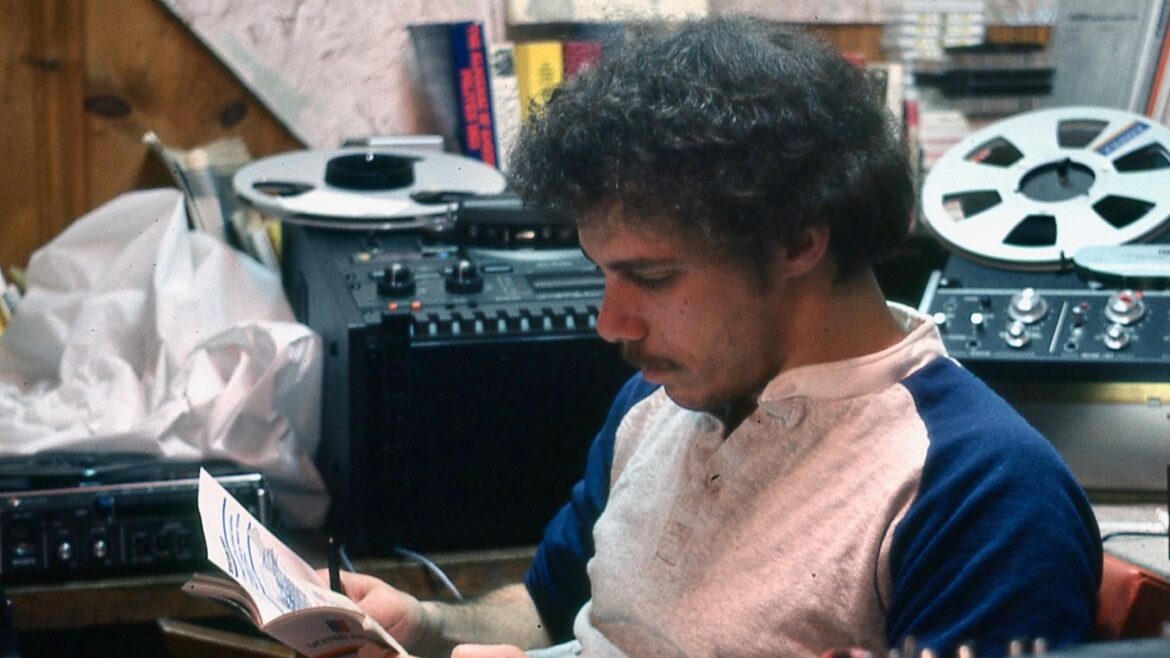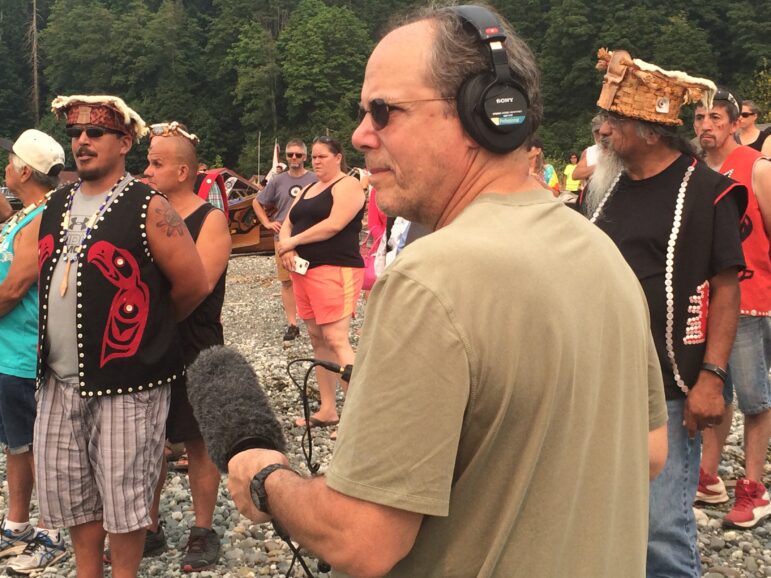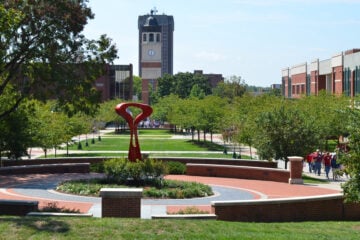From alligator clips to high-speed internet: the past, present and future of remote work at NPR

Eric Epstein
NPR reporter Howard Berkes at his home and office, an old mining cabin in Salt Lake City's Allen Park Canyon, in 1983.
When Howard Berkes began reporting for NPR in the 1980s, he carried a canning jar wrench with him in his recording kit. That allowed him to remove the mouthpiece from a telephone if it was glued shut. He’d then attach alligator clips to the two metal prongs inside the mouthpiece; the other end of the cable went to his tape recorder.
“By plugging in a microphone to your tape deck you could talk down the line that way, file your tracks or do a live two-way,” he said.
Berkes spent 38 years working remotely for NPR, and those telephones he used in the early days were often borrowed.
“You’d beg for a phone somewhere,” he said. “I’d knock on doors, or if you were in an office or a school, you’d just say, ‘Can I use your phone?’ And then they’d watch while you started unscrewing the mouthpiece.”
Berkes has seen technology advance leaps and bounds in the four decades since he joined NPR as a correspondent based in Salt Lake City. While the pandemic has accelerated the pace of change and increased the sheer number of people working remotely, NPR has had at least some remote workers for nearly its entire existence.
Squeaky wheels and spear tips
NPR established its National Desk “acquisitions unit” in 1979 and by 1982 had eight regional correspondents across the country. Berkes and the others were contract workers at the outset, which he said created inequity compared to full-time staffers.

“I had to supply my own tape. … We had to buy our own supplies,” Berkes said. “We didn’t get the same kind of support that the reporters working in Washington or at bureaus got.”
The correspondents filed suit with the National Labor Relations Board in 1982, challenging their status as contractors, and successfully convinced NPR leadership to hire them as full-time staff. Still, the remote nature of the work required them to be vocal about the unique challenges they faced, said Berkes.
“It really took NPR a while to get used to the fact that there were these reporters who weren’t in a bureau and weren’t coming into the building,” Berkes said. “That’s one reason I became a union activist at NPR and a shop steward, was because we were pretty much ignored for those basic things that employees had in Washington and at the bureaus.”
Berkes recalls an instance when he was talking to someone in human resources about not getting information about open enrollment for insurance. Her response was that they had posted notices in the elevators.
“I think the people working for NPR remotely now have no idea what it was like to do it in the ’80s and early ’90s, when we had to fight for attention and support,” he said.

One element that has been crucial to the success of remote correspondents is NPR’s Operations Desk, which was established in the early ’90s. Shahran Thomas-Fulton joined the team in 1999 as a producer and is now VP of content operations. She said remote workers were often the “pointy end of the spear” when it came to adopting new technologies.
“They are individuals operating alone … and they become their own engineers. They need to be able to do a lot,” said Thomas-Fulton. “They would become so expert in what they needed … bringing in new applications, new tools, and they would start utilizing those things to the point somewhat where engineers and other people back at HQ would be like, ‘What are you doing now? What are you utilizing?’”
Technological changes
Howard Berkes remembers subscribing to at least a dozen daily newspapers from the eight Mountain West states he covered.
“My letter carrier hated me for it because I had this stack of newspapers every day,” he said.
His home office was outfitted with a reel-to-reel tape recorder, which he purchased himself. When he wasn’t on a tight deadline that necessitated filing by phone, he’d ship tapes to NPR overnight.
“We also sometimes put tapes on airplanes,” Berkes said. “You’d run down to the airport with a tape … and someone in D.C. would then have to go to the airport there and pick it up.”
ISDN was a game-changer when NPR started using it in the late 1980s. Berkes said his ISDN install was the first in the Salt Lake City area; he was also the first person to file high-quality audio in real time from his phone, according to Michael Cullen, NPR’s technical director of master control, operations and production support.

“You could just talk your tracks down the line, feed your tape live down the line,” said Debbie Elliott, who joined NPR’s National Desk in 1995 and works out of her home in Orange Beach, Ala. “[You could also] do remote interviews. If you wanted somebody in a studio and not just phone tape, you could arrange for somebody to be in a studio wherever, and you could record on your end the ISDN.”
Cullen said NPR used ISDN extensively for 30 years, even after widespread adoption of the internet in the early 2000s.
“The speeds were so much slower in the beginning,” he said. “I remember [in 2006 or 2007], when I was the technical director of All Things Considered … the executive producer saying, ‘We can’t accept any internet-based filing after noon because it takes too long to get here in time to get on the air by 4:00.’”
Even such antiquated technologies as fax machines proved beneficial for NPR’s earliest remote workers.
“Because that gave you a way to send your script to your editor,” said Elliot. “I’m telling you, it was the Dark Ages.”
Elliot also remembers those alligator clips and the logistical challenges of being a remote correspondent in an era before mobile phones.
“Let’s say I’m covering a trial and waiting for the verdict,” she said. “You would have to either make a friend in an office somewhere in the courthouse or know where a nearby pay phone was that you could get to before the other reporters did.”
Another huge shift came in the form of digital recording technology. For remote recording, NPR moved away from cassettes and quarter-inch audio tape in favor of minidiscs and digital audio tape, or DAT, in the mid-1990s. (NPR continued to use reel-to-reel audio tape to produce programs until the early 2000s). By the mid-2000s, NPR began providing reporters and producers with digital recording devices that stored audio on memory cards, the same technology still used today.
You get a Comrex! And you get a Comrex!
Perhaps the single most important technology to change the landscape for NPR’s remote workers was high-speed internet, which gave reporters and producers the ability to quickly file high-quality audio from almost anywhere.

“In the majority of the cases, wherever you’re traveling nationally or internationally, there are so many more places that provide more bandwidth than before,” said Rolando Arrieta, NPR’s director of content production and operations. “It has enabled folks who go out in the field to have better systems in place for the content that they have to produce in the field.”
Remote correspondents like Elliott and Berkes were some of the first to receive Comrex Access Portable units, which allowed them to deliver high-quality audio live over the internet. These units were key to keeping NPR on the air and sounding good during pandemic lockdowns and are still an essential part of its technological arsenal. Arrieta said that pre-pandemic, only a handful of NPR’s anchors and hosts had Comrex units.
“Now all of them have it,” he said. “That creates a quality of life where, [if] suddenly a host, for whatever reason, has to host from home, that’s no problem. We’ll just change the connection and boom, they’re connected from home and they sound great.”
Applications like Report-IT and Riverside.fm have further expanded the possibilities for remote recording and production. Whereas reporters once had to ask interviewees to travel to a studio with an ISDN line or satellite uplink in order to capture high-quality audio, now they just ask them to download an app.
Arrieta said NPR is in the process of building a new content management system to make it even easier for reporters and producers in the field to file. The goal is for the revamped system to accommodate “our new production paradigm,” said Arrieta; it will work as efficiently inside NPR headquarters as it will on a mobile phone from the field.
“It’s an exciting time to stay on top of all that and [make sure] our content creators have the tools to be able to tell their stories,” he said.







I still have an Otari MX5050B sitting in the closet. It weighs more that all the rest of my studio put together!